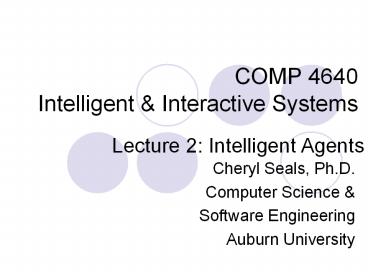COMP 4640 Intelligent - PowerPoint PPT Presentation
Title:
COMP 4640 Intelligent
Description:
For the when part, it may be best to measure performance over an extended period ... legs, mouth, and other body parts for actuators ... – PowerPoint PPT presentation
Number of Views:15
Avg rating:3.0/5.0
Title: COMP 4640 Intelligent
1
COMP 4640Intelligent Interactive Systems
Lecture 2 Intelligent Agents
- Cheryl Seals, Ph.D.
- Computer Science
- Software Engineering
- Auburn University
2
Intelligent Interactive Systems Lecture2
- Intelligent Agents
- An Agent is anything that perceives its
environment via sensors and acts upon that
environment via effectors. - In this course, we will be interested in the
design of rational agents, i.e. agents that do
the right thing giving a sequence of percepts. - In order to design rational agents (and also to
be able to judge whether they are actually
rational!) we must know - how to evaluate an agents success
- when to evaluate an agents success
- The how part is accomplished through the
development of a performance measure. - For the when part, it may be best to measure
performance over an extended period of time
however, at times it may be advantageous to have
intermediate performance measurements along the
way.
3
Agents
- An agent is anything that can be viewed as
perceiving its environment through sensors and
acting upon that environment through actuators
- Human agent eyes, ears, and other organs for
sensors hands, - legs, mouth, and other body parts for actuators
- Robotic agent cameras and infrared range finders
for sensors - various motors for actuators
4
Agents and environments
- The agent function maps from percept histories to
actions
- f P ? A
- The agent program runs on the physical
architecture to produce f
- agent architecture program
5
Vacuum-cleaner world
- Percepts location and contents, e.g., A,Dirty
- Actions Left, Right, Suck, NoOp
6
Intelligent Interactive Systems Lecture2
- For an agent, one can determine rational behavior
based on - the performance measure of the agent,
- the percept sequence (this is the collection of
all of the percepts received by the agent), - what the agent currently knows about the
environment, and - the set of actions that the agent can presently
perform.
7
Rational agents
- An agent should strive to "do the right thing",
based on what it can perceive and the actions it
can perform. The right action is the one that
will cause the agent to be most successful - Performance measure An objective criterion for
success of an agent's behavior
- E.g., performance measure of a vacuum-cleaner
agent could be amount of dirt cleaned up, amount
of time taken, amount of electricity consumed,
amount of noise generated, etc.
8
Intelligent Interactive Systems Lecture2
- Ideal Rational Agents
- An ideal rational agent is one that performs any
action that is expected to maximize its
performance measure given its percept sequence
and its built-in knowledge. - Ideal rational agents are formed by ideal
mappings from percept sequences to actions - An ideal rational agent may have some sense of
autonomy. That is, it may be able to learn,
adapt, and operate successfully in a variety of
environments.
9
Intelligent Interactive Systems Lecture2
- Structure of Intelligent Agents
- The objective of AI is the design and application
of agent programs that implement mappings between
percepts and actions - An agent can be viewed as a program that is
developed to run on a particular architecture
(some computing device). - The architecture
- makes percepts available,
- runs the agent program,
- sends actions to the effectors
- Types of Agent Programs
- Intelligent systems are typically composed of a
number of intelligent agents. Each agent
interacts (directly or indirectly) with one or
more aspects of an environment. This type of
agent interaction is similar to what we see in
sports, business, and other organizations that
are composed of a number of different agents with
different responsibilities working together for
the common good.
10
Intelligent Interactive Systems Lecture2
- There are a number of different agent programs
however, many can be classified as one of the
following - Simple Reflex (Reactive) Agents
- Goal-based Agents
- Model-based Agents
- Utility-based Agents
- Communication-based Agents
11
Simple reflex agents
12
Vacuum-cleaner world
- Percepts location and contents, e.g., A,Dirty
- Actions Left, Right, Suck, NoOp
13
Model-based reflex agents
14
Goal-based agents
15
Utility-based agents
16
Learning agents
17
Next Class
- Chapter 2 (continued)
- Agent Examples
- Agent Environments































